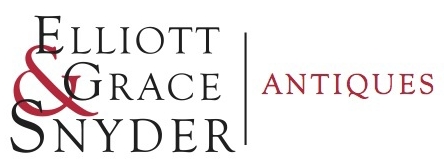Fine small three-knop brass candlestick with suppressed ball as center knop.
Netherlands, c. 1500.
In excellent condition. 5 1/4” h.
Provenance: Purchased decades ago from the collection of Jan Koldeweij, father of Eloy Koldeweij, author of The English Candlestick 1425-1925.
Bronze Winged Candlestick
Rare bronze “winged” candlestick in superb condition.
Netherlands, c. 1350-1400.
7 1/2” h.
SOLD.
Three Kings Candlestick
One of the finest examples we have seen—an unusually bold and tall “three kings” candlestick.
Flemish/Netherlands, c. 1500.
17 1/4” h. In superb condition.
For similar examples, cf. Brons en Messing, pp. 31-2.
SOLD.
Brass Waxjack
A wonderful 18th century brass waxjack with elaborate scrolled base and feet and finial depicting a youth holding a wine bottle in one hand and a glass in the other.
Dutch, 1st half 18th c.
Brass Carrying Lantern
An elaborately decorated carrying lantern with hinged handle to hold extra candle, and reflector sconce in the interior. On unusual “shell” shaped ridged feet, with cut-out tulips, and repoussee decoration. In excellent condition.
Dutch, late 17th - early 18th c.; 10 ¼” h.
SOLD.
Steel Fork with Heart Motif
Exceptional late 17th c. steel fork with multiple hearts and scrolls.
English, c. 1680-1700.
17 1/2” h.
Sugar Cutters
A truly special pair of sugar cutters engraved with a lady and gentleman on one side, and a love poem on the other. The inscription reads: “For love is of, A truer Kind, When they are, With virtue entwined. There is no flower, That lovelier Blooms, Than when two hearts, Have but one mind.”
Germany, probably, Nuremberg, early 18th c.
SOLD.
Wrought Iron Trammel
A bold and unusually large wrought iron trammel with scrolled hearts and a snake "finial"—no doubt used in a cooking fireplace.
French or Flemish, late 17th -early 18th c.
In excellent condition.
46” l.
Silver Pique Snuff Box
A delightful silver pique snuff box depicting a festive scene of musical entertainment.
English or French, c. 1725.
3” x 2 1/4”
Marriage-Themed Tobacco Box
An unusual Dutch brass tobacco box commenting on the consequences of power-sharing in a marriage: with a monkey orchestrating chaos, the inscription reads (roughly):
”Where the woman (wife) rules and wants to be guardian over the house..there things are already wrong..there is no bigger cross."
Signed under the monkey, “A.V. Houte."
Both sides are identical.
Netherlands, c. 1700.
3 3/4” diam.
Queen Anne Taperstick
A superb 18th c. English Queen Anne taper stick with exceptional detail, in excellent condition. Underside shows evidence of original gilding.
England, c. 1740-5.
4 3/4” h.
For related stick, cf. Gentle and Feild, English Domestic Brass 1680-1810, p. 117, fig. 27.
Whimsical Utensil Rack
A beautifully designed utensil rack, the sheet-iron plate with a cut out star motif flanked by cut out hearts, topped with an exuberant floral motif centering on a single iron and copper flower.
Flemish or French, 18th c.
For related racks, cf. H R D’Allemagne, Decorative Antique Ironwork, p. 340.
Rare Standish
A very fine and rare brass and iron standish with original red fabric wind shield/penwipe in the shape of a flame.With adjustable candleholder on an iron shaft topped by a brass finial in the shape of a dog, four bird finials atop the elaborately embossed brass standish top, ending in four brass claw feet holding up a shaped iron base.
Continental, prob. French or Italian, first half 18th c.
In excellent condition with only a small bit of ribbon trim missing from the flame-shaped shield.
Provenance: Kindig collection.
Large Gothic Candlestick
An extraordinary oversized late Gothic brass candlestick in fine condition.
Netherlands, c. 1500-25.
13 ¼” h
Fine Brass Goffering Iron
A rare nicely turned tripod-base brass goffering iron with paw feet.
England, c. 1780-1820.
In excellent condition.
9” h.
The Steel Menagerie
A group of four steel choppers in the shape of different animals. French, late 19th c.
Elephant - a very rare form with incised details; 11” l. SOLD.
Horse - a beautifully shaped form in fine finish; 12” l.
Fox with inlaid copper eye; 10 1/2” l.
Bird with inlaid copper eye and inlaid handle; 10” l.
Three Very Fine Goffering Irons
L to R:
Unusually large steel goffering iron in excellent condition. 10 1/4” h. SOLD.
Beautifully “turned” delicate steel goffering iron in excellent condition and color. 8 1/2” h. SOLD.
Probably the earliest of the group; wrought iron in a great design. 9 1/4” h. SOLD.
While it’s difficult to find agreement among scholars on both precise origin and age, these are likely British/Welsh and 18th-early 19th c.
Country Life
An exceptional hand-painted tray depicting a very active village scene.
English, c. 1820.
Excellent condition.
21 ¼” x 30 ¼”
Unusually Bold Candlestick
An unusually bold Iznik candlestick in wonderful color and condition.
Turkey, late 16th-early 17th c.
7” h.; 7” base diameter.
Window Grille with Shutters
A rare survivor—a complete early window set with elaborate heart decorated ironwork grille, shutters, and frame.
Spain/Spanish provincial, 16th c.
31 3/4” w. x 38 1/2” h.








